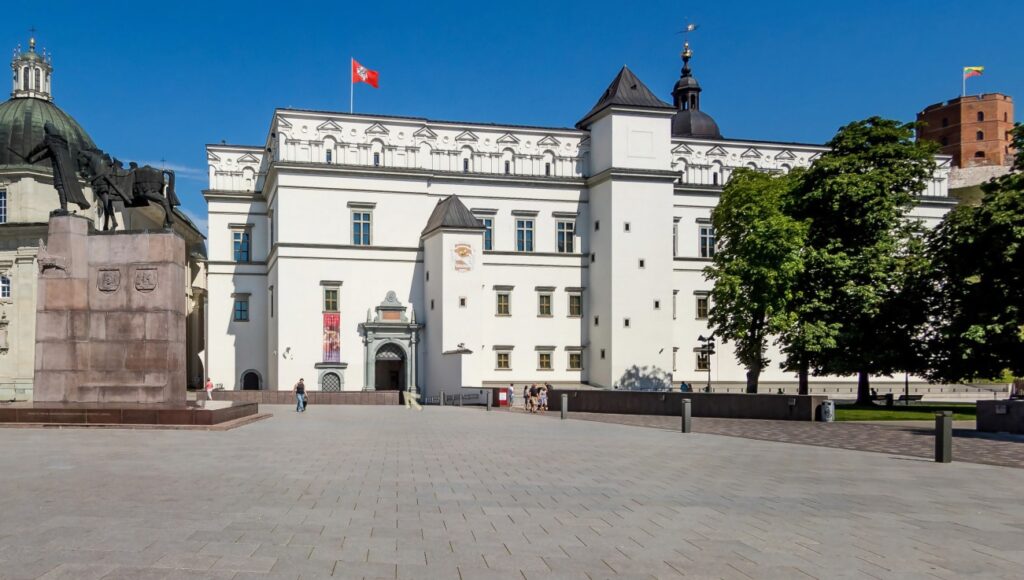VILNIUS CHURCHES
Vilnius is famous for the beautiful houses of worship of various religions. If you are looking for a place that has all the thrilling religious life of European capitals you are lucky on your way. See Vilnius Churches.
The Church of St. Anne

The Church of St. Anne (Maironio St.8) is probably the most famous structure in Vilnius. It is a masterpiece of late Gothic, nearly unsurpassed in the world.
According to the latest data, it was designed (1495-1500) by Benedikt Rejt, an architect of the Jagiellons. It has survived into our days almost unchanged. The church was renovated in 1902-09, and the facade was reinforced in 1960-70.
Many legends are related with this church. Particularly popular is a story that on seeing St.Anne’s, Napoleon wanted to put it on his palm and carry it over to Paris. Actually, he used the church for the needs of the French cavalry.
A surprisingly light, harmonious and graceful building, it is noted for a rhythmical composition of vertical and curved lines. No solid masonry is placed above the portal, only pilasters, slender quadrangular poles, arches of three types and elegant pinnacled towers crowned with metal crosses.
Church of the Immaculate Conception of Blessed Virgin Mary

In 1907, the city government allocated a plot to build the church.
This Church (Sėlių str.17, Vilnius) was started to build in 1911. Church walls are brick. Church style is Neo-Romance and historicalism. The church plan in the form of a Roman cross, 50 m long, 32 m wide, 23 m high.
The project of the church was finished in 1907. After the first world war church construction was resumed. In 1922, a parish was founded.
In 1925, a service began to be held in an unfinished church.
After World War II, the church was repaired.
Interior of the church is bright, rubbing, the vast nave taller, with an additional bar of oval windows. There are many religiously and artistically valuable paintings in the Church.
The church is characterized by excellent acoustics, there are large organs. The impression of coziness and warmth is enhanced by wooden floors.
The Church of St.John
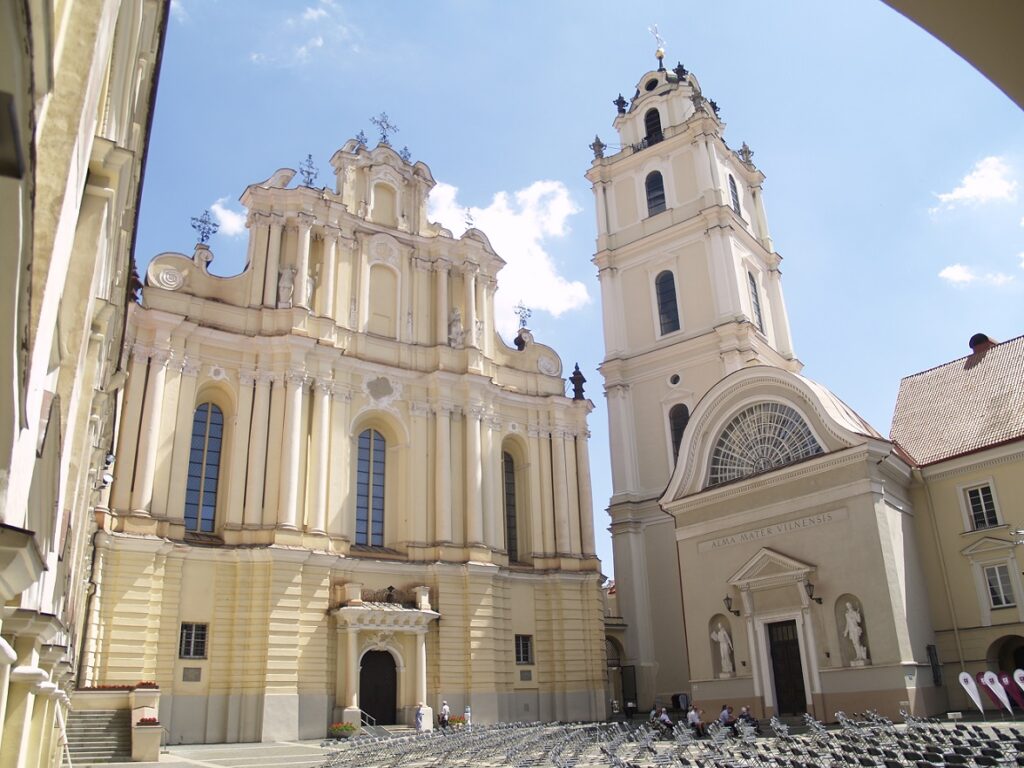
Church of St John (Šv. Jono g.12) is situated around 13 courtyards. It contains buildings and works of art of various styles and from different periods.
Nowadays the main entrance is through the Library Courtyard, from where the superstructure of the Observatory is visible. The decoration of the superstructure reflects the principle of announcing the content of the building on its outside.
Above the windows, in the painted medallions under the curved pediments, are symbols of the planets.
The most impressive part of the Great Courtyard is the Church of St.John and its bell tower. It was built as a parish church and was finished in 1426. Today its Gothic forms and interior space are concealed under its Baroque and neo-Classical reworkings.
The church has a nave and two aisles, and no towers. The facade is like a symmetrical, undulating mantle shrouding the tall Gothic inner space. It also relies on the Baroque principle of making the decoration more complicated higher up.
No less impressive is the rear of the church overlooking Pilies street. The undulating wall is decorated with reliefs, columns, scrolls, statues and vases.
Franciscan Church

The Franciscan Church (Pranciškonų St.1), is situated in between Trakų, Kėdainių, Lydos and Pranciškonų streets. It is a very archaic area in Vilnius.
The Franciscans established themselves on this site before Lithuania’s Christianization. Their church is one of the oldest city buildings: a brick church or chapel stood on this site as early as the middle of the 14th century.
Burial sites dating from the late 13th-early 14th century have been discovered. They were partly destroyed while laying the church foundations. Thus, before the construction of a brick church, a cemetery was located on this site, apparently at a wooden church. Burials took place according to Christian traditions. This allows us to assume that it is one of the earliest Catholic sites in Vilnius.
Church of St.Peter and St.Paul

It is the most exquisite Baroque monument in Vilnius (Antakalnio St.1).
Since the times of Lithuania’s Christianization a wooden church stood there, destroyed during the 1655-61 war with Moscow.
The present Church of St.Peter and St.Paul was built by hetman Michael Casimir Pac to mark the liberation of Vilnius from Russians and his own escape from the hands of rebellious soldiers. Construction began in 1668 according to a project by architect Jan Zaor.
The church acquired its present appearance in 1676. In 1671-1704 it was decorated with stucco moldings, and frescoes. Pac died in 1682 and did not see the church finished. In 1801-04 Giovanni Beretti and Nicolae Piano renovated the building and created a rococo pulpit.
Church of St.Casimir and the Jesuit Monastery
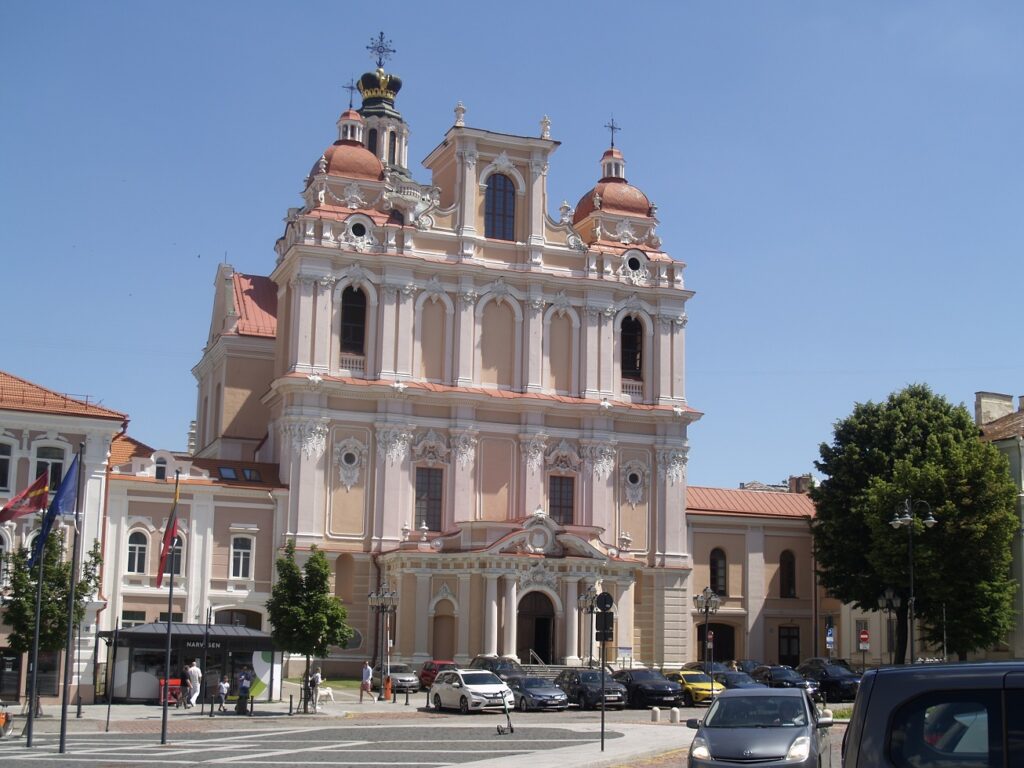
The ensemble is located on the east side of the Town Hall Square (Didžioji St.34).
The construction of the church began in 1604 in memory of the holy prince Casimir. It was built by the Jesuits with funding by the Great Chancellor of the Grand Duchy Leo Sapieha. It is traditionally assumed that the corner stone was pulled into the city by a procession of 700 Vilniu sites from the Antakalnis hills.
The construction was finished in 1616, and the interior design completed in 1618.
The Church of St.Casimir is one of the earliest exemplary Baroque buildings in the city, designed along the line of the famous Il Gesu church in Rome. It was apparently designed by Povilas Bokša.
In the middle of the 18th century the church was reconstructed by architect Tomas Žebrauskas. Under his supervision a stepped lantern cupola with a crown was erected. This large and impressive cupola is unique in the entire region of the former Grand Duchy. More…
Vilnius Cathedral

After being baptized in 1251, Grand Duke Mindaugas probably built the first cathedral on this site.
It was a brick building with a massive square tower on the west side. Its remains – foundations and glazed tile floor – were discovered in 1973-76 in the vaults of the present Cathedral.
The building contained elements of a transitional style from Romanesque into Gothic.
After Mindaugas’ death (1263) the Cathedral might have been turned into a pagan sanctuary again. The remains of two brick stairs traversing the nave, discovered in 1984 may have survived from this period. More…
Church of St.Archangel Michael
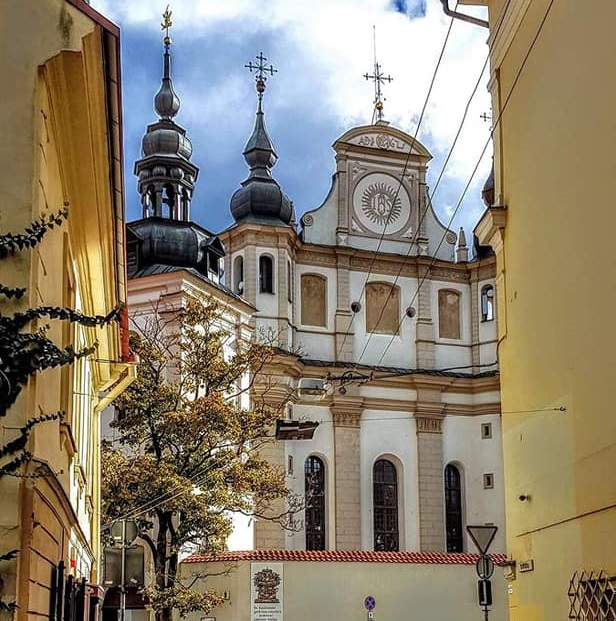
It is a unique Renaissance ensemble (Šv. Mykolo St.9), which forms a beautiful counterpart to the Gothic of the Churches of St.Anne and Bernardines.
In 1594-97 the church was commissioned by the Chancellor of the Grand Duchy Leo Sapieha as a mausoleum for his family.
The construction was finished in 1604, but in 1627 the roofing fell in. Later stonemason Jonas Kajetka rebuilt it.
During the 1655-61 war with Moscow the Cossacks burned down and ravaged the church; it was renovated in 1663-73.
A Baroque belfry was built in the 1st quarter of the 18th century. The church was closed down by the tsarist authorities in 1888, and in 1905 returned to the Sapiehas, renovated in 1905-12.
In 1933 both the church and monastery were renovated again.
In 1972-2006 the Museum of Architecture operated in the church. Now it is home for the Museum of Church Heritage. More…
Bernardine Church

The Bernardine Church (Maironio St.10) is one of the largest Gothic sacral buildings in Vilnius.
It acquired some features of Renaissance and Baroque in the 17th-18th century. Being much larger and more archaic than the church of St.Anne, it forms an interesting and unique ensemble with the latter.
Bernardine monks built a wooden church in 15th century, and later – a brick one. In the early 16th century it was reconstructed.
Afterwards it was renewed many times, particularly after the 1655-61 war with Moscow. In the times of the Soviet occupation it was closed down and handed over to the Art Institute.
In 1994, the brethren of St. Francis returned to the church, and presently it is under restoration. More…
Church of St.Catherine

The Church of St.Catherine (Vilniaus St.30) is regarded by art historians as the most typical example of Vilnius Baroque.
This type of late Baroque churches is noted for slender and elegant twin towers. A picturesque silhouette of the Church of St.Catherine stands out in the whole panorama of the old town.
The history of the ensemble goes back to 1618, when hetman John Carol Chodkiewicz and his wife Sophia invited Benedictine nuns from Nesvizh to Vilnius. They built for them a small brick church, which was later expanded and after the 1741-73 reconstruction acquired its present appearance.
The church was damaged in 1812 and during the Second World War, but was restored afterwards.
At the present time the church is one of the most popular concert venues in Vilnius.
The church facade is dominated by vertical lines. It is abundantly decorated, the pediment and towers are adorned with volutes, vases and beautiful open-worked crosses with rays. This single-nave church has 9 magnificent late Baroque altars and a pulpit. More…
Church of St.Jacob and Philip

A twin tower church of St.Jacob and Philip and the Dominican Monastery (Vasario 16-osios st.11) was built on this site in 1624.
The present building dates from the late 17th-18th century. It is a single-nave church with cylindrical vaults; an image of the miraculous painting of the high altar occupies the niche above the portico.
The niches hold wooden 18th century statues of St.Hyacinth and St.Dominic.
During Soviet times plans were advanced to demolish the church. In 1992 it was returned to its parishioners. A painting of the Holy Mother the Compassionate famous for its miracles was also returned to the church.
The monastery was established in the 18th century.
The Dominican monks ran the hospital, until it became the first secular city hospital in 1808.
The monastery was reopened in 1993.
Church of the Assumption

The construction of the ensemble of the Missionary Church of the Assumption (Subačiaus St.28, Vilnius) and the Missionary Monastery began in 1695 at Subačiaus Gate.
In 1750-56 it was basically reconstructed by architect Jan Krzysztof Glaubitz.
The church is one of the most subtle and elegant late Baroque buildings in Vilnius. Its light and well-proportioned towers with rounded corners adorned with decorative cases, lattices and open-worked crosses.
The front and back pediments are dynamic and have rolling forms. The vestibule is a picturesque domical rotunda. It is echoed by the pediment of the servants’ house on the left.
In 1844 the church and the monastery was closed down by the tsar’s order. From 1862 on services were held in the church again. In the Soviet period the church was closed down, and in 1993 returned to its parishioners.
The function of the monastery changed more than once. It was used as a war hospital (1844), a Russian Orthodox consistory (1848), an Institute of Noble Girls (1856), a psychiatric hospital (1859), a welfare society (1874).
Gate of Dawn
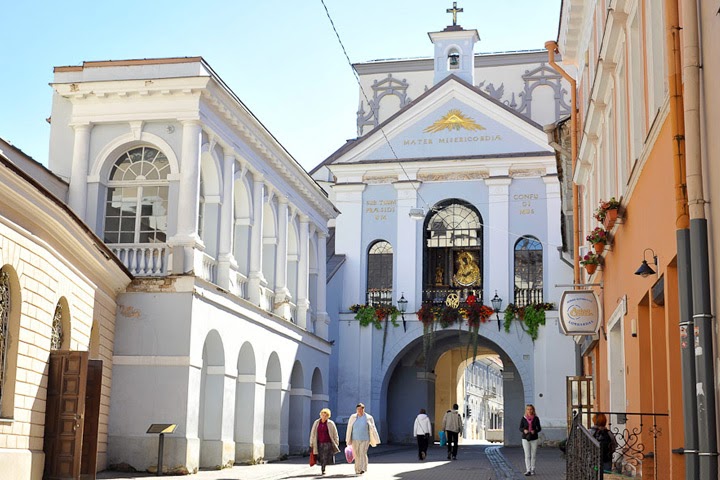
It is one of the symbols of Vilnius – a Catholic sanctuary famous in all Lithuania and abroad.
A gate built on the road to Medininkai, Ašmena and Minsk, initially called Medininkų Gate. The Gate of Dawn has a square plan and gothic masonry (except for a Renaissance top and attic).
The entry arch is covered by a cylindrical vault. There are some traces of a heavy iron gate under the arch. Loopholes can be seen on the south side. Among them is a niche with a fresco, above it – a cornice with a sculptural head of the patron of merchants Hermes, or Mercury. Higher up is a Renaissance attic with architectural motifs and two relief-work griffins, holding the lithuanian coat-of-arms Vytis.
The painting of the Mother of Mercy of Aušros Gate is known to all Catholics of the world. The painting of the Holy Virgin Mary, called the Madonna of Vilnius, is dated by the 1st quarter of the 17th century. It is painted in the Renaissance style. The Virgin Mary is depicted without Child, with her head tilted to the right, her hands are crossed over her chest.
Pope John Paul II prayed and showed a special honour to Mary of Aušros Gate in 1993, and Pope Francis – in 2018.
Church of St.Theresa

One of the most excellent early Baroque monuments in Vilnius. The church (Aušros Vartų St.14) was built in 1633-50. Swedish sandstone, granite and marble, were used for construction. The monastery dates from 1621-27. The church was renovated after 1812, in 1927-29 and 1971-76.
The facade of the Church of St.Theresa was designed according to the models of Roman architecture. It is noble and harmonious, built along the vertical principle, and accentuated by volutes and side obelisks.
A massive octagonal belfry is crowned with a weathervane – an angel with a trumpet. The church is built along a basilican design and has a wide central and two narrow side naves and a blind cupola.
The early Baroque monastery buildings are moderate and simple. Picturesque courtyards are divided by arches. The Barefoot Carmelites of Vilnius used to brew beer famous in the whole city.
Church of the Divine Mercy

On the site of the present church (Dominikonų St.12, Vilnius) a Gothic single-nave church was built in the 15th century.
It was reconstructed after the 1748 and 1749 fires: a new presbytery and two towers were built on, and in place of a Gothic apse a new portal was erected. The church belonged to the university.
The tsarist authorities converted it into a Russian Orthodox church in 1821, but in 1920 it was returned to the Catholics.
In Soviet times the church was abandoned. In 1968 part of the facade with a portal collapsed. In 1971 the early Gothic three-wall apse was reconstructed in that place. A 16th-18th century building has survived closer to Šv.Jono St. Its ground floor accommodated men’s almshouse, and the first floor – a deanery.
After the First World War it housed the Club of Vilnius Lithuanians and the Vilnius Union of Lithuanians Students. In 2004 the church was adapted for worship of the picture “Mercy of God”, painted in 1934, according to the vision of St.Faustine.
Church of St.Ignatius

A picturesque by-street connects Dominikonų and Liejyklos streets. On its southwest side stands the Dominican Monastery, and on the opposite side – the Church of St.Ignatius and the ensemble of the Jesuit Novitiate (Šv.Ignoto St.6).
The church was built 1622-47. Devastated by fires, in 1748-50 it was reconstructed. In the tsarist times it housed an officers’ club.
In 1925 the temple was restored and became the Vilnius Garrison Church. After the war it was closed and later turned into a pavilion of the film studio. Since 2004 the church has been serving the spiritual needs of the military.
The main facade with early Baroque obelisks is quite decorative and original.
Church of All Saints

The church (Rūdininkų St.20, Vilnius) was built in 1620-30 in the early Baroque (so-called Carmelite) style.
A belfry was erected in the 18 th century. In Soviet times the church housed a museum of folk art, and presently it has been returned to its parishioners.
The high and massive belfry tower is magnificently decorated. There are 18 Baroque altars inside.
A large old-regulation Carmelite monastery adjoins the church. It is built by adapting existing buildings. In 1631-32, the main two-storey building following the street was completed.
In the 16th-18th century they actively participated in public life, held religious feasts and processions. In 1819 the Carmelites established a parochial school in the monastery.
Church of the Holy Cross

On the site of the present church and monastery (Daukanto Sq.1) Vilnius Bishop Povilas Alšėniškis built a Gothic Chapel of the Holy Cross (1543).
In 1618 a two-storey house merged with the chapel. In 1635 the Bonifratri monks who had come to Vilnius converted the house into a Baroque church. It was reconstructed several times in the 18th century. In 1976 a concert hall called the Small Baroque Hall was appointed in the church.
At the present time the church is open to its parishioners.
It is the only church in Vilnius transformed from a dwelling house. With its simple forms and small mass it harmonizes with other buildings in Daukanto Sq.
Late Baroque and rococo dominates in the interior. The high altar holds a painting of the Holy Virgin Mary of Snow considered miraculous. Her image is duplicated on the facade fresco.
A holy Cross House, opened in 2002, and run by the Poor Sisters of the Immaculate Conception, offers a broad range of services those who need social assistance.
In front of the church stands a monument to architect Laurynas Gucevičius.
.
Church of the Holy Spirit
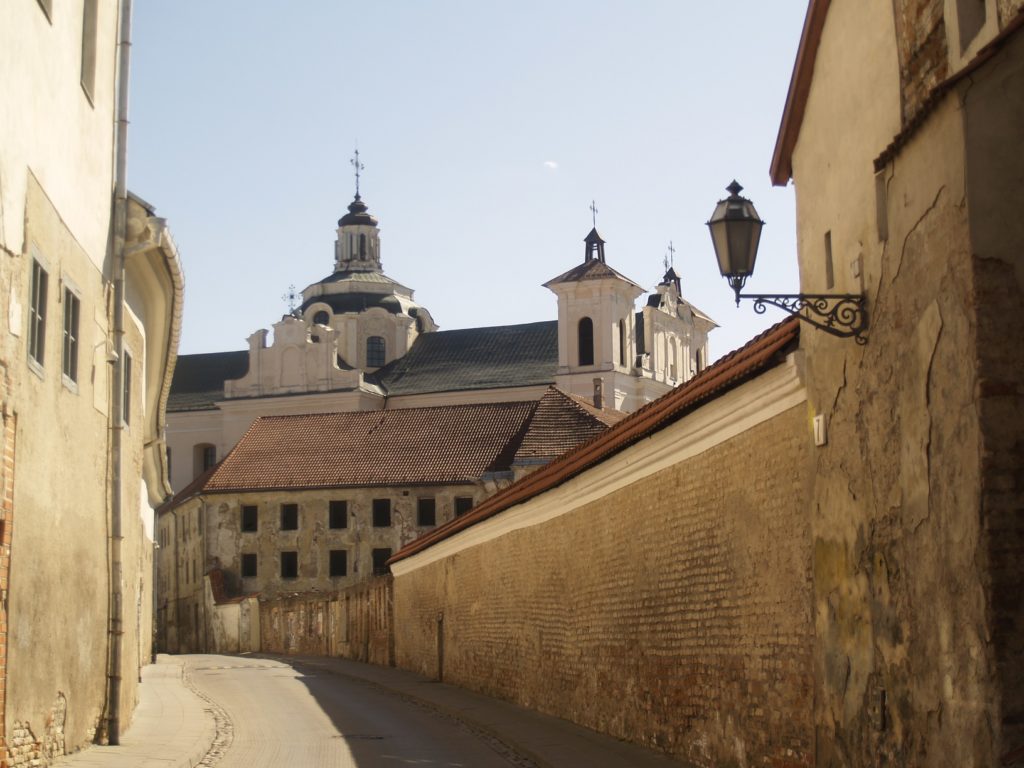
The Dominican Church of the Holy Spirit (Dominikonų St.8) is one of the most magnificent Vilnius churches.
An excellent monument of high and late Baroque. Crowned with a mighty cupola, it stands out in the panorama of the old town and can be seen from surrounding streets.
In 1408 Vytautas built the Church of the Holy Spirit that was later expanded. In 1501 Alexander Jagiellon gave it to the Dominican Monastery. The walls of the church survived from that period. The cupola was reconstructed in 1752-60.
Today it serves the Vilnius Polish Catholic community.
The church stands sideways to the street and does not have a clearly designed main facade. Its height with the cupola is 51 m. The bottom part of the facade is covered over by monastery buildings.
The exterior has features of high and late Baroque.
Church of St. Raphael the Archangel

St. Raphael Church (Šnipiškių St.1, Vilnius) was consecrated in 1730.
After the suppression of the Society of Jesus in 1773, the Church and the monastery were given to the Order of Piarists, whose goal was the Christian education of youth in schools.
In 1791 the Church was transferred to Pilaites parish. Army barracks were set up in the monastery. The Church was turned into a warehouse. The Church was returned to Catholics in 1860.
The monastery was reconstructed in 1974 with its original appearance partially restored. The Department of Cultural Heritage of Lithuania is currently located in the monastery.
The Church was constructed in Baroque-style as a rectangular tripartite basilica.
Its interior contains nine remaining altars. Some more notable 17th century paintings, reminiscent of Jesuit times, can be seen in this Church: “St. Ignatius Loyola”, “St. Francis Xavier” and the image of Joseph Calasanz, the founder of the Piarists. The main altar painting depicts St. Raphael the Archangel, escorting young Tobias home from a difficult journey.
In 1904, the President of the Republic of Lithuania Antanas Smetona and Sofia Chodakauskaite – Smetoniene were married at St. Raphael’s.
Church of the Finding of the Holy Cross
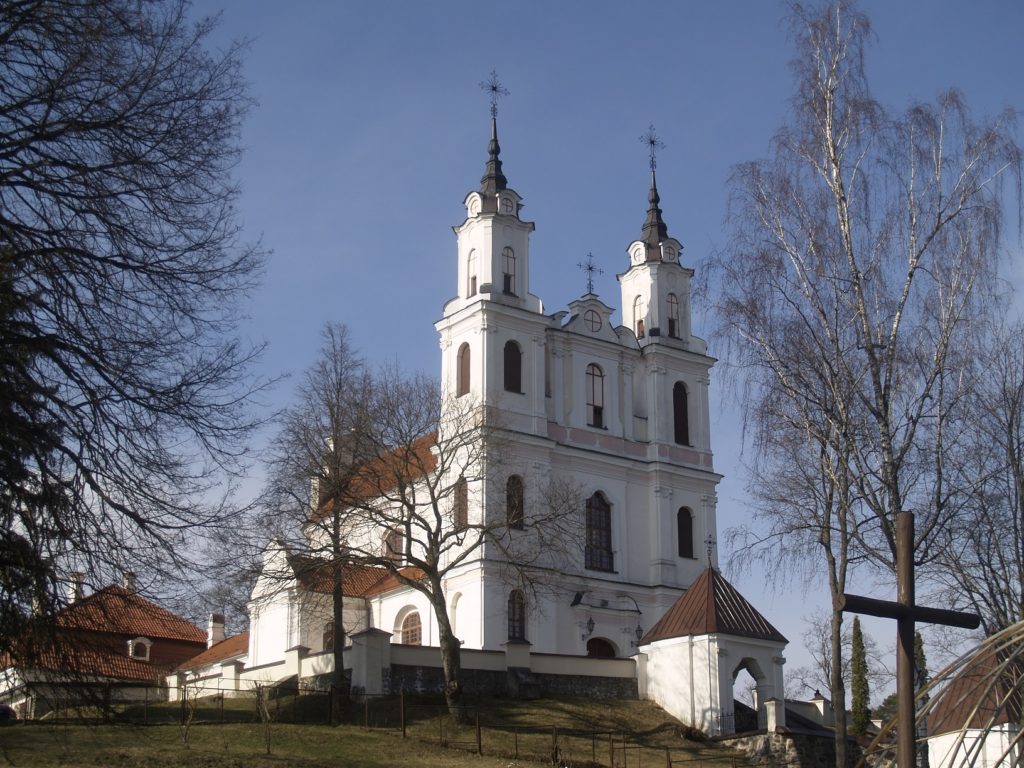
The Calvary Church of the Holy Cross (Kalvarijų St.327, Vilnius) is located in the Jerusalem of Vilnius, on the right bank of Neris. The style of the church is of the late Baroque period. It stands within the territory of Verkiai Regional Park.
Masses are held in Lithuanian and Polish.
The masonry church of the Holy Finding was built in 1700. In 1812 the church was badly devastated by the French army. After the war, it was refurbished.
The Church of the Discovery of the Holy Cross also known as the Calvary Church and the Dominican Monastery stand on a high Jerusalem Mountain near the Way of the Cross. The symbol of the Church of the Discovery of the Holy Cross is the Golgotha Mountain.
Architecturally, the church is a vaulted basilica of Latin- cross shape.
Church of Lord Jesus

The Trinitarian Church of Our Lord Jesus (Antakalnio St.27, Vilnius) is situated north of the Sapieha estate, on the former possessions of the Sapiehas.
It was built by the Efforts of Casimir Sapieha in 1694-1717. Twin towers, not quite harmonizing with the Baroque forms of the church, were built on in the 18th century. In 1864 the church was converted into Russian Orthodox church and severely damaged.
In the 1920’s it was partly renovated. The church has an impressive cupola, the interior is adorned with stucco relief works and sculptures – a large part of them has survived.
Nearby stand buildings of the Trinitarian Monastery from the late 17th-18th century. The Trinitarians were a missionary order. In the 18th century the order’s collegium operated in the monastery, and a parish school was established there in 1726.
In 1993, the church and convent buildings became the Seminary for Priests. Finally, in 2000, they were restored to their original use as site of a religious community, becoming the brothers’ current priory of Saint John the Theologian.
East of the church, Sapieha Park and Antakalnio Cemetery, stretch the Sapieginė Hills beloved by skiers.
Church of St.Stephen

The Church of St.Stephen (Geležinkelio St.37, Vilnius) can be seen from a terrace of Geležinkelio St.
This late Renaissance church (1600-12) is one of the earliest in Vilnius suburbs. St.Lazarus’ almshouse operated at the church, plague and famine victims were buried there.
Severely damaged during a fire in 1794, the church was reconstructed and slightly transformed in 1801-06 (architect Pietro Rossi). The construction works were accelerated by a gift of 3000 silver roubles from tsar Paul I who was passing through Vilnius.
In 1864 the convent was closed down, and the buildings converted into a prison. In 1926 it housed the stone-crushers’ guild. In a cemetery at the church many outstanding people were buried, among others architect Laurynas Gucevičius. The sanctuary and some of its surrounding buildings are under restoration.
Church of St.Nicholas

This church (Šv.Mikalojaus St.4, Vilnius) is one of the oldest in Vilnius and Lithuania. Its Gothic features have survived almost unchanged. The church stood in the pagan Vilnius.
It was first mentioned in 1387. The Gothic pillars and vaults went up in the 16th century. The belfry is Baroque. Of moderate forms, and accords with the style of the church fairly well.
In 1901-39 the Church of St.Nicholas was the only church in Vilnius where the mass was held in Lithuanian. By the same token it was a centre of Lithuanian culture.
Plain and even primitive, the redbrick building nevertheless attracts the eye by its coziness and tranquility. Its facade is flanked by two stocky buttresses with cut-off tops. Bricks are laid in the Gothic manner, in many places irregularly.
The walls are not quite straight, the angles not quite right, and the apse has an irregular plan. Of the Gothic part, only the niches, edgings and pediments are plastered. The triangular pediment with niches has been recently renovated accentuating its original Gothic character.
St.Casimir Church in Naujoji Vilnia

The construction of the church (Palydovo g. 15, Vilnius) began in 1905 at the initiative of the city’s residents and priest Anicet Butkiewicz.
It was originally planned to completely plaster the facades of the church, but this was abandoned. The construction of the church was overseen by architect Seweryn Houwalt. Construction completed in 1911.

